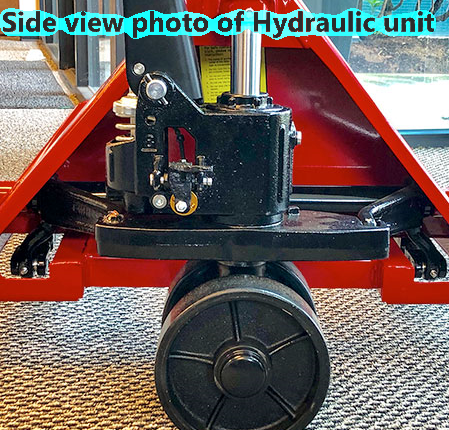The correct tires in good condition are an essential aid to safe and efficient operations.
 |
| Forklift tire options |
The tires are the only parts of a forklift that are always in contact with the ground. They provide grip for movement, friction for braking, and an element of suspension for safety and comfort.
Worn tires can lead
to excessive fuel consumption or battery discharge, overheating, and even physical
damage to components.
Forklift tires have three main categories:
- Air Pneumatic
- Solid Pneumatic
- Cushion/Press-on
Load wheels are a separate category and come in a variety of solid compounds.
Air Pneumatic Tires
Air-filled pneumatic tires are
the classic tire style for conventional sit-down forklifts. They are similar in
concept to automotive tires in that they're filled with air, but are designed
to handle the heavy loads that forklifts carry. They operate at much higher air pressures, usually 100-120 PSI. Because of these
pressures and the heavy loads it is especially critical that they are maintained
properly, as any failure can be extremely dangerous. Low tires can cause serious accidents.
Solid Pneumatic Tires
Solid pneumatic tires are solid rubber or composite tires. They fit the same
wheels as their comparable pneumatic tires (bolt-together or split ring rims).
The primary reason to use these tires is their increased durability in harsh
environments such as recycling plants and other sites with sharp debris, where frequent flat tires are a concern.
These tires can be molded in normal tread patterns, but are
available in the smooth tread for warehouse applications, and also in non-marking
compounds (recognizable by their light grey or white color).
Cushion Tires
Cushion tires, also known as press-on tires, are solid rubber as
well but are designed to fit special rims. They are molded around a steel
ring, which is pressed onto the rim with a high-powered hydraulic press. These
types of tires come in a variety of compounds and treads. Most applications are
smooth tread for maximum tire life and smoothness of operation. A common
alternative is a finely sipped tread, which is remarkably effective for wet
surfaces like dock plates. Similar to pneumatic profile solids, they also are
available in non-marking compounds. These require the use of static
straps to dissipate static so that onboard electronics are not interfered with
or damaged. Lack of a static strap can also equal an unwelcome surprise to the
unsuspecting operator when they exit the lift truck!
With solid tires, the biggest factor in performance is the molded
compound. Some compounds offer enhanced traction for specific environments,
while others may be optimized for durability, smooth ride, or cold storage
usage. Usually, a tire is given a durometer rating, which denotes its hardness,
but is only a part of the picture. A higher durometer rating is harder than a
low one. For example, a load wheel with a durometer designation of 80 would be
softer than an 85. Be sure to discuss the proper tire for your application when
you talk with your parts or service representative.
There are also a few things to keep in mind to avoid
problems:
- Inspect all tires daily for damage
- Maintain proper tire pressures and wheel tightness
- Always replace tires with the equivalent type (the same size, type, and performance specification)
- Never use mismatched tires (type/size/wear/pressure/etc)
- Do not attempt to repair or modify a wheel or its components because this can affect the strength and integrity of the assembly.
Don’t wait until tires are worn out before you replace them!
We offer FREE tire pressing with the purchase of a drive tire or hub.
 |
| FREE Tire Pressing with purchase |
Order your tires here.
We have a huge selection of forklift replacement parts, make sure to check here first.




























